Marathons: Paul #72, Leah #62 : Pikes Peak Marathon 2015
16th August 2015, Manitou Springs, Colorado, USA
Finish Time = 7:37:56
We’re 13,000 feet up a mountain, the headache that started to come on at 11,000 feet pierces my eyes which can now only see in tunnel vision. Everything feels like it’s moving in slow motion, I certainly am. I sway and stagger to the side and Leah puts her arm out worried I’m going to go over and off the edge of the trail to a nasty fall. She’s handling the altitude a lot better than me it seems. I never thought I’d be in a marathon where the sight of other runners bleeding is no longer a surprise. The only way to get down and off the mountain is to continue to run up another 1,000 feet of rocky ascent to the 14,115′ summit, the halfway turnaround point. There’s a storm coming in. I could turn around now but giving up isn’t something I do. There is no other option but to keep going.
This is the Pikes Peak Marathon.
This is “America’s Ultimate Challenge”.
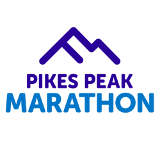
Ever since I came over to Colorado in 2010 I had been fascinated by the idea that a marathon was held each year that ran up one of Colorado’s “14ers” (mountains higher than 14,000 feet). Pikes Peak has the highest summit of the southern Front Range of the Rocky Mountains of North America. Running up to the summit was only half of the race; runners also had to run back down it again, which I had often read was equally as hard due to the steep trail and exhausted legs.
The race starts at 6,300 feet above sea level, runners then face an elevation gain of 7,815 feet to the summit at 14,115′ and then back down for a total change of 15,630′. The average grade on the ascent is 11%. I couldn’t comprehend how anyone could do this.
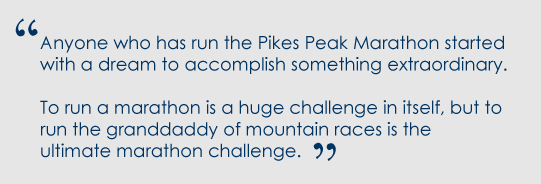
Source: Official Pikes Peak Marathon book
After visiting the summit of Pikes Peak on the Cog Railway I found I didn’t feel particularly great at over 14,000 feet just walking around for the 30 minutes they let you stay there, let alone needing to exert effort that high up. It remained something I often thought about and occasionally dared myself to consider, but each year when registration would open, and fill up within 24 hours, I would think no… it’s just too crazy. We would joke about it on our training runs, if we experienced a really tough road marathon or if we ever struggled up hills we’d say “Can you imagine what Pikes would be like?” and we would quickly reason that no, how could we ever imagine?
I would find it included in lists of the World’s Toughest Marathons, like this article which lists it as the 2nd toughest of the 15 shortlisted:
http://www.weather.com/news/news/worlds-toughest-marathons-running-20121103/#/15
Or on this website, listed as the 1st in a list of Most Extreme Races:
http://www.active.com/running/articles/most-extreme-races
On the training portion of the official website it is explained that “The ascent portion of the race is a relentless uphill grind. Combine that with the continued drop in oxygen as the elevation increases and the physiological demands placed on every runner are exceptional.” The website also explains that “there’s a reason trees don’t grow above 12,000 feet.. because they can’t.”
The fact that it is billed as America’s Ultimate Challenge appealed too much to the challenge-oriented side of me. I would always wonder, “Could I complete America’s Ultimate Challenge?”
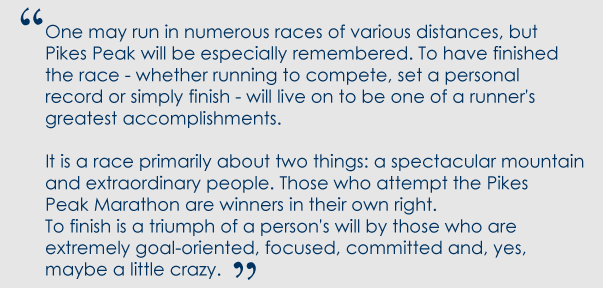
Source: Official Pikes Peak Marathon book
I decided that when the registration opened in 2015 I would go for it. For various reasons it might be the last chance I get and we had been running strong, even better than in 2014. Leah wasn’t convinced but also said she didn’t want me to die alone on the mountain and would enter too. When it opened we signed up, included our proof of qualification and 10 hours later the race was filled with all 800 spots taken.
We tried to mix some hill training in but it was tricky with our work schedules where we were both at sea-level and also with the other regular marathons we still needed to keep running leading up to the event. By the time Pikes came around in August we’d already run 20 marathons so far in the year, all of which were in less than 4 hours. After running the Barr Trail Mountain race as training in July we knew it was going to hurt us, and we had already signed up to another marathon just 13 days later that we needed a sub 4 finish at for our States challenge. Needless to say we were a little apprehensive when we arrived for race morning.
We had kept a close eye on the weather in the week leading up to the event and after some bad flooding in the town and thunderstorms predicted we were concerned whether the event would go ahead at all. One of the biggest threats to runners is lightning and above the treeline it’s exposed and there’s no protection for runners against the elements. This was one of the scary aspects and in the official website guidance it says:
“Lightning deserves its own heading separate from weather because it can come out of the blue! Indeed, the possibility of lightning poses the single greatest threat to runners, especially above treeline. Mother Nature is very unpredictable regarding this element! If you are caught in severe lightning, it is best for a group to spread out and crouch down with your feet planted on anything that will insulate you from the ground.”
As we got closer to the race day there were still storms on the radar but were predicted to hold off until the early afternoon. Before that it was bright sun. So we just needed to get up to the top and head back down to the treeline before the storm came in!
What to bring?
Opinions vary on what to carry for the event, ranging from a large amount of stuff to very little. A lot of this comes down to personal preference and the weather closer to the time. The forums on the Pikes Peak website are a good resource as well as the Facebook group. We prefer to carry as little as possible so in the end decided on:
GU gels (as always), salt tablets, arm warmers (for above the treeline), gloves (also for above the treeline and where the rocks get bigger, you might need them for scrambling), sunglasses / hat, biodegradable wipes – there are no toilets on the course, handheld water bottle. I carried mine in an SPI belt.
On the morning of the race, after checking our kit bag and cheering to the traditional rendition of “America The Beautiful”, we lined up in our wave start group.
We looked up at the mountain summit in front of us and the enormity of the task ahead was obvious. We could even see a snow patch on the top and here we were in singlets enjoying the sun. Shortly afterwards the gun set us off.
There was around a mile of road to reach the start of the Barr Trail that would lead us up Pikes Peak Mountain. Even during that first mile we were already feeling the difference in altitude from having been mostly at sea level in the weeks before.

A mile through the town of Manitou Springs before reaching the beginning of the trail. Photo credit: Internet source
The trail is largely single file at the beginning with occasional areas to overtake. It was more crowded than during the Barr Trail Mountain Race, perhaps because by doing a wave start based on qualifying time we were all within the same running ability so people didn’t spread out much. We didn’t mind this though, we weren’t in it for a time, this was about completing the challenge.
We had also heard several people talking around us saying you have to save some energy for above the treeline. This sounded sensible although we didn’t know how much to save or how much harder it would be once we reached that part.
The first few miles looked familiar from having run Barr Trail although it was more washed out due to the recent rains. We were running the miles slower than we had in Barr Trail, but it didn’t really matter. This was about the long-game, we weren’t going to be finished after 12 miles unlike that race. It was also much, much hotter than when we had run Barr. The sweat was pouring off us and combined with the altitude, dehydration was definitely something we needed to be mindful of.
While we were running through a lot of trees, there were also areas that cleared and offered stunning views. It was incredible to turn and see just how far we had actually climbed up. As we approached 10,000 feet we were starting to get dizzy. I would liken it to the feeling of having a few drinks and you’ve started to feel the effects. It adds an extra layer of complexity because you’re running over rocks, leaping up and over boulders and constantly having to watch your foot placement. Doing that while dizzy is a challenge.
When we hit 11,000 feet in addition to the dizziness I started getting a strange sensation like I was losing my spatial awareness, almost like I had tunnel vision. Well, all I needed to do was to concentrate on what was in front of me I suppose.
Above the Treeline
At 12,000 feet we finally broke through the treeline, the trees literally just stopped growing and instead the landscape was large rocks and dusty trail. The wind was much more noticeable without any shelter.
At this altitude the headaches started and our hands and feet were noticeably more swollen. Everything was becoming harder, including breathing. By the time we got to 12,500 feet to add on top of the list of altitude-related issues I was suffering, everything felt like it was going in slow-motion and like I was walking through treacle. I was also swaying from side to side and stumbling over the rocks, quite often catching my toes on them. Leah stayed behind me and a few times on some of the steeper edges tried to grab me as I swayed. There were several people in a line behind us with me at the front. I just wanted them to go on ahead as I was not doing well but as it turned out, neither were they.
I led the stumble-train up another 500 feet of climb. That’s when I began to realise, there’s no way out of this. I’m 13,000 feet up a mountain and feel like I might just slip out of consciousness and the only way I can fix it is to go back down to a lower altitude. The only way I can do that is to climb another 1,100 feet to the summit to turn around. There’s no way I could face turning around before getting to that point. The only way was up.. and that was all I knew.
I had previously read about the effects on the body at different altitudes:
Another source, related to altitude for pilots quoted:
10,000 feet. The blood saturation has dropped to 90 percent and your brain is receiving the absolute minimum supply of oxygen. This is the absolute highest altitude at which you should have any trust at all in your own performance although your judgment is already severely compromised. Euphoria will prevent true self-assessment of your abilities. Physical hypoxic symptoms such as tingling and headache may not become apparent for four hours or more at this altitude, although judgment has long gone by the wayside. Above 10,000 feet blood oxygen saturation and performance degrade steeply.
14,000 feet. Blood oxygen saturation is down to a dangerous 85%. You will be increasingly disabled at this altitude. Vision will dim. You will experience serious degradation of judgment, memory and thought. The impairment of judgment will leave you feeling just fine and confident in your performance, however. If hypoxia is not recognized and corrected at this stage of impairment, it is unlikely that it will be recognized. You are in serious danger.
Encouraging.
We came to the “16 Golden Stairs” which sound great but are actually steep rocks you have to climb with high step-ups.
It wasn’t long before we started seeing the lead runners heading back down, and the etiquette is that you have to give way to runners coming downhill, often stopping and stepping completely to one side on the narrow trail to give them a clear path. Quite honestly I was glad of the break and thankful downhill runners were often unaware that my casual leaning against the side of a boulder to let them pass was more often an excuse to collapse onto the rock and hold on for a while. I felt like I pulled it off pretty well. I probably didn’t.
We did still take in the magnificent views though and couldn’t believe it when looking down the mountain, at how far we had climbed up. Looking down you could see hidden mountain lakes, paths where huge rocks had ripped through the mountain after falling and it was a new experience being above the level that birds were flying.
Eventually we rounded the final switchback and saw the banner at the summit.
We reached the top in 4 hours 17 minutes. I grabbed a cup of water and after finishing it, filled it up with jelly beans from one of the tubs. I found a rock and just sat down trying to get myself together again. The sugar from the jellybeans felt good but I definitely ended up eating far too many… by the time you realise it you’re already in sugar overdrive.
Now we’ve got to get back down!
After a while we started to make our way back down, by this point we’ve usually finished our marathon a while ago but today we still had half of it to go.
Going down was hard, your energy levels are low and legs are tired and don’t want to work. There are some big rocks above the treeline which are tough to climb up but equally tricky to traverse getting back down. We could see some storm clouds coming in and knew we needed to get back down to the treeline as quickly as possible.
I started to get a painful cramp in my thigh, I tried to run through it but it was affecting my stride and movement of my leg. I caught the front of my toes on a rock and went flying. I threw my arms out but at the last split second just about managed to regain my balance and stay on my feet. I decided in my head at that moment in time, that if I did end up going down I was just going to just stay there and lie on the trail for a bit. That sounded perfectly reasonable to me and like heaven at that point.
We made it back down to the treeline at 12,000 feet just as some rain started. We had made it through the part that can be the most variable and is the most exposed for runners. Best of all we hadn’t been zapped by lightning and there was no blood loss as neither of us had fallen. After a couple more thousand feet of descent we started to feel more normal again and the dizziness was subsiding.
We were completely out of energy though and really had nothing left to give. We were taking the downhill much slower than we could have done, firstly it was incredibly easy to lose your footing on the uneven rocks when combined with the fatigue and secondly we knew we had a road marathon in less than 2 weeks where we would need a sub 4. We also stopped several times to find large rocks off the trail for “comfort breaks”. There are no actual toilets on the whole course so you have to improvise.
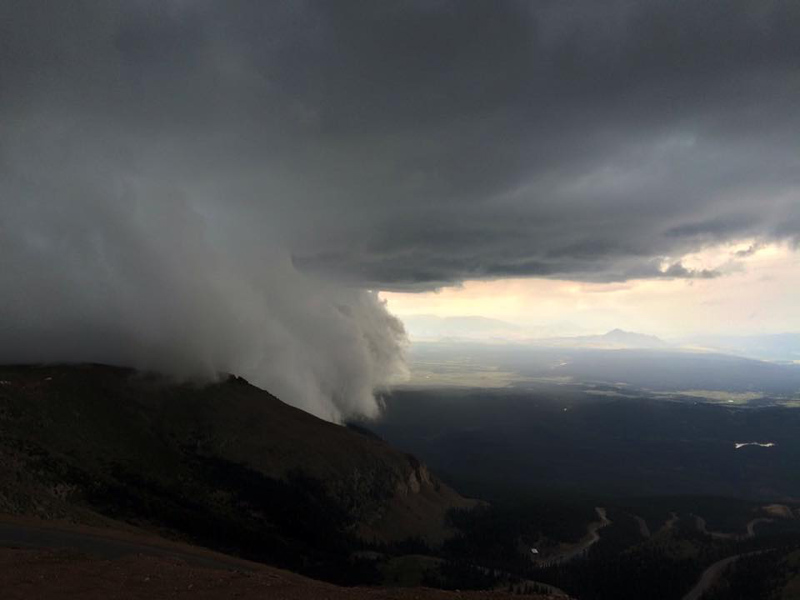
This picture was uploaded by the County Search and Rescue team to the marathon Facebook page and was the storm cloud we saw coming in. They said it was a nasty, fast-moving lightning storm which chased the aid station volunteers off the mountain. Glad we didn’t get caught up in that
We saw several people hit the ground and at one point a guy in front of us went down pretty hard. We stopped to make sure he was okay, he had fallen previously in the race and with this second fall had re-opened up the same cuts from the first. Not nice. We stayed with him for a bit but he said he wanted to just stay on the ground for a while and that he would be okay. I completely sympathised with this frame of mind, given it was how I had felt not so long ago.
We went through a lot together coming down that mountain. We went to a place both mentally and physically that we hadn’t been before. We had nothing left to give and our fuel was gone. It had been over 8 hours since we’d even had any proper food to eat. We tried to remember the positives; there were a lot of struggles but a lot of natural beauty, a lot of empty trails but huge cheers at each aid station. We went through a period where we just stumbled along trying to find the will to keep running longer than a minute or two.
At one point we just stopped and gave each other a hug
We didn’t quite know how we were going to get through the rest but we just knew we needed to carry on down the mountain to complete the challenge.
We dug deep and between us we found the strength to pick up the pace and run fairly consistently through the last 5 – 6 miles. Sometimes you push yourself harder than you would on your own, because if the other person is running you don’t want to be the one to stop them. If you’re both thinking that way, you both keep moving. It was a huge relief when we ended the trail path from the mountain and were back on the road. This road would lead us to the finish line, around a mile away. We picked up the pace and actually ran the last mile in 7:56, our fastest mile of the entire run!
As we rounded the final corner the announcers read out our names and we crossed the finish line together. In just over 7.5 hours we had completed America’s Ultimate Challenge.
The only thing we could do, which goes against all advice on what you should do, was to just fall onto the chairs immediately after the finish. Some volunteers handed us water and an ice-bag each that we put on our head and neck to try to cool down from the 80+ degrees we had just been running in. A medic asked us if we needed any medical assistance, we said that we would be okay. A few minutes later she came back again and asked “Are you sure you don’t need medical help?” I looked over and saw a couple of people on intravenous drips. Come to think of it… one of those actually sounds pretty good. I almost wanted to ask if they had a menu of services I could look at. We both felt awful.
We moved away from the medical area and were presented with our medals. This definitely brought on a smile, I couldn’t believe I had actually earned a Pikes Peak Marathon medal.
After we had our pictures taken we went and sat in some shade. We didn’t really talk much at first, we just sat staring at nothing, lost and trying to work out what to do to start feeling remotely human again. Usually after a marathon our legs hurt or feel tight and we stretch and instantly feel better. That wasn’t the issue this time and it wasn’t that simple. This was more along the lines of “how do you fix a body that feels like it’s slowly been shutting down?”
Even though by this point we didn’t feel hungry we knew that food was probably the answer. We made our way out of the finish area and across the road where the post race food was being served. I managed 2 slices of pizza, less than my mind wanted me to eat but just a little more than my stomach wanted to take in. After a while we went back to the car to drive home, after all we both had to fly out for work the next morning!
Reflecting on the race
Sometimes when I look at the medal I still can’t believe we completed the challenge, for so long we had looked at it as some kind of near-impossible feat and by achieving it, it has become another reminder that nothing is impossible as long as you believe you can do it. When you complete something you thought was impossible your definitions get redefined and your world opens up.
Sometimes when you complete something you thought was out of your reach, you start to think “Maybe it wasn’t that hard after all?”. That’s not the case at all with Pikes Peak. Completing it hasn’t taken anything away from how hard this event is; however tough I expected it to be, which was already a high expectation for me, it was much, MUCH tougher than that.
Everyone who went up and back down that mountain that day and in every year previous, regardless of finishing time, has my utmost respect.
Now whenever we see Pikes Peak towering above all the other mountains around it, we’ll always be able to remember the day we ran to the top of that.. and back down again.
Elevation Graph from my running watch:
We love hearing your comments and feedback! Please feel free to add something using the form below. When you press Post Comment it might seem like it has disappeared, but it has been sent to us. We’ll read and publish it as soon as possible. Thanks!

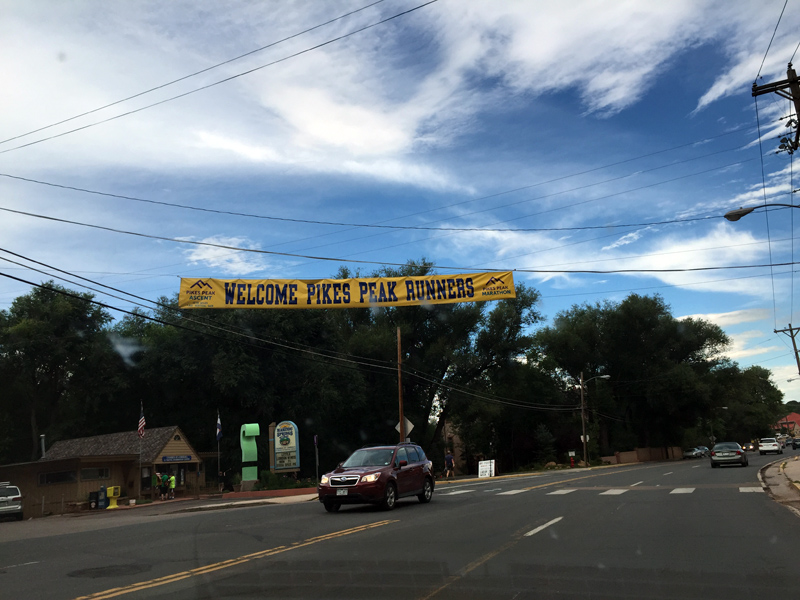
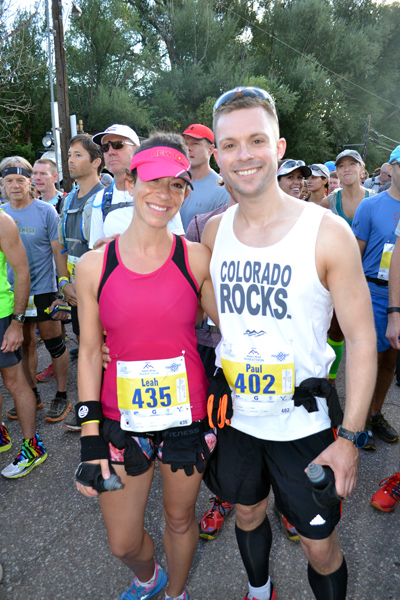

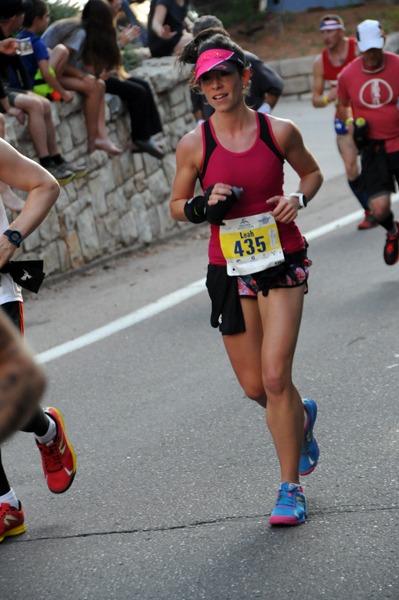

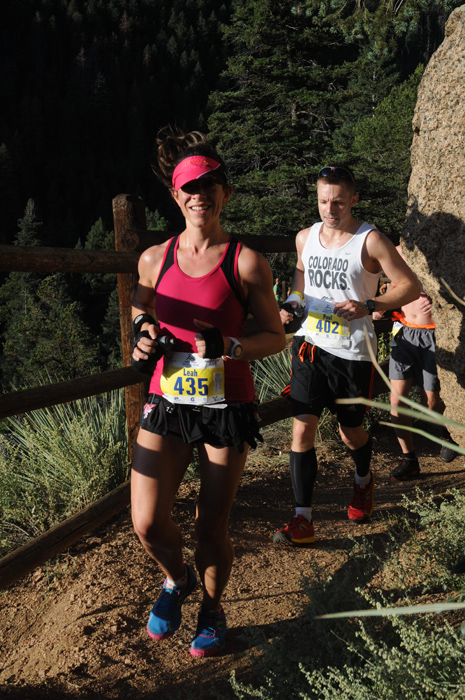

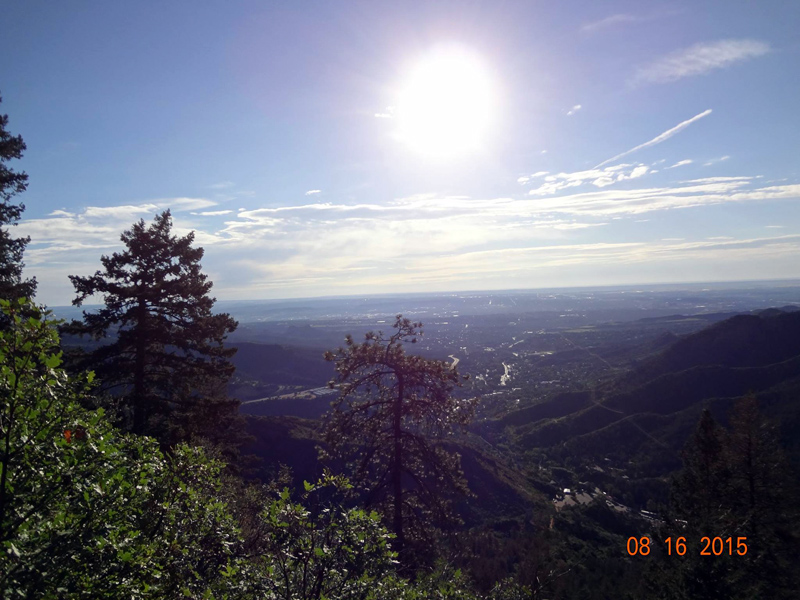
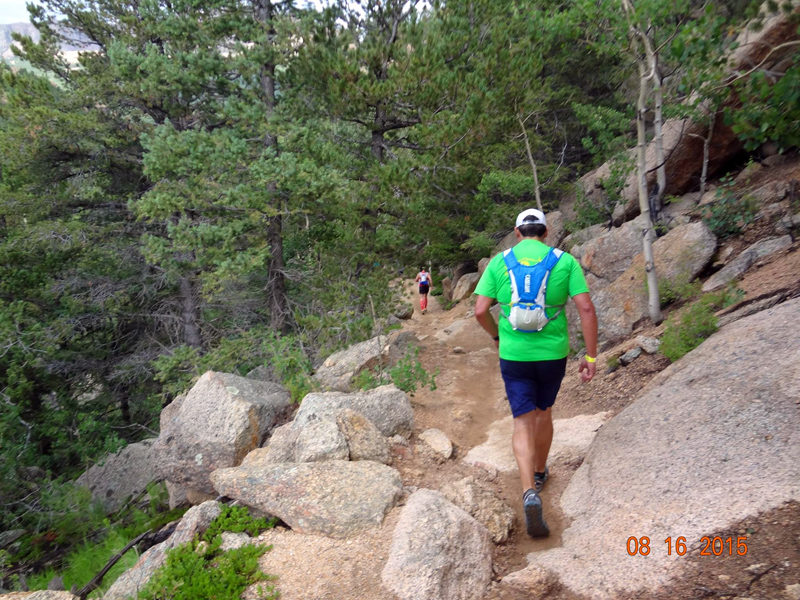
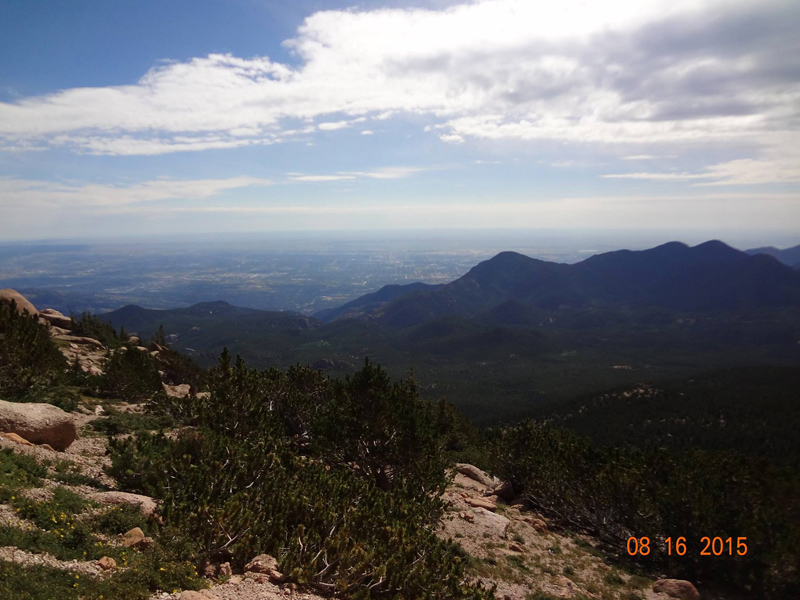
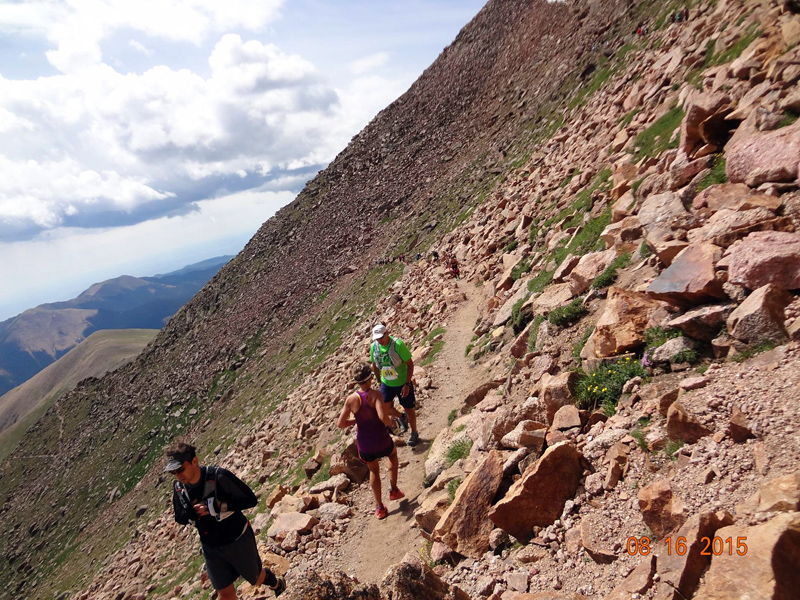
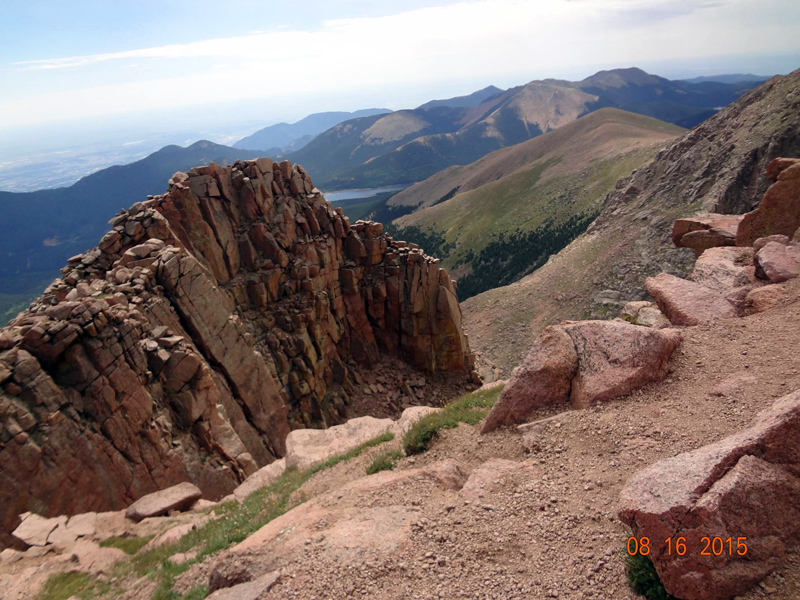
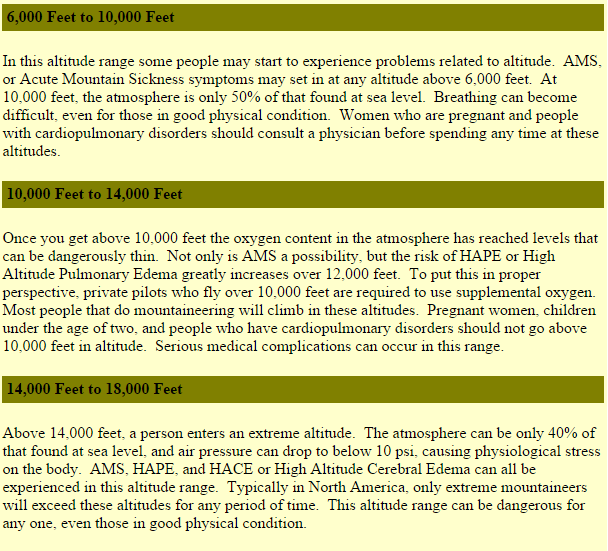
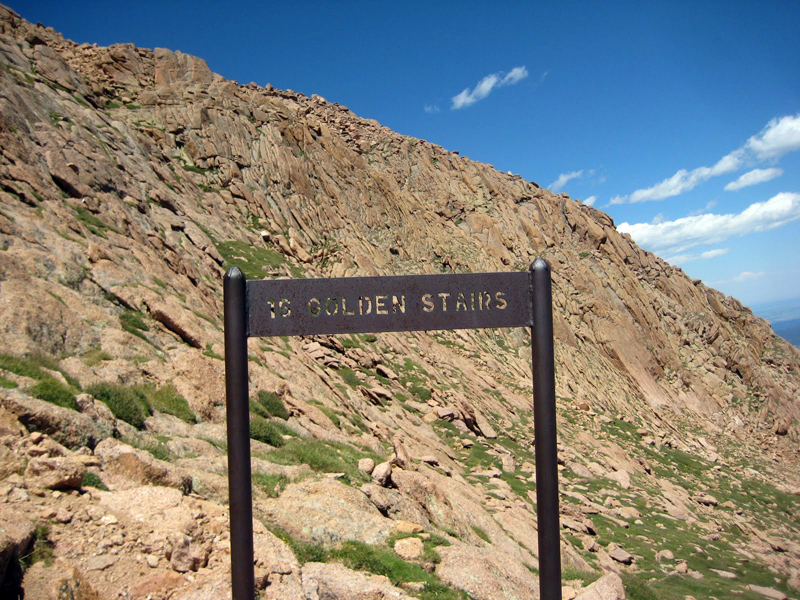
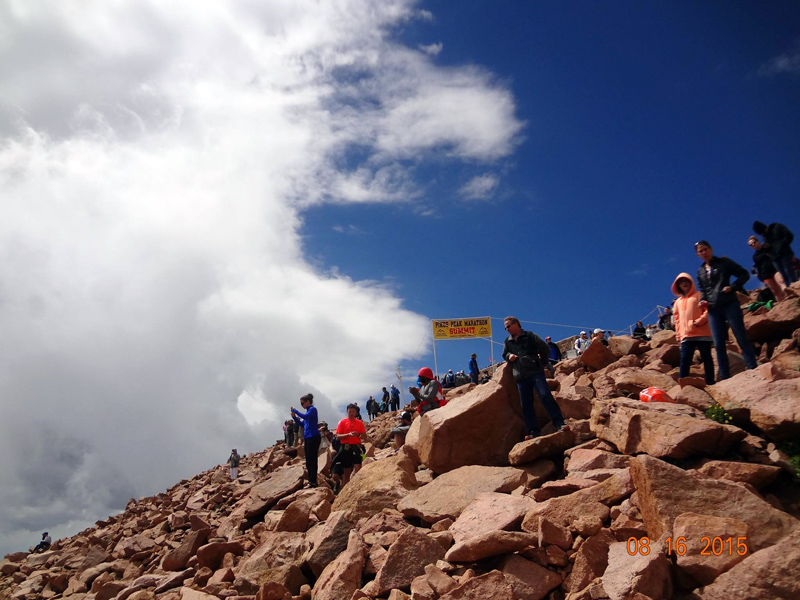
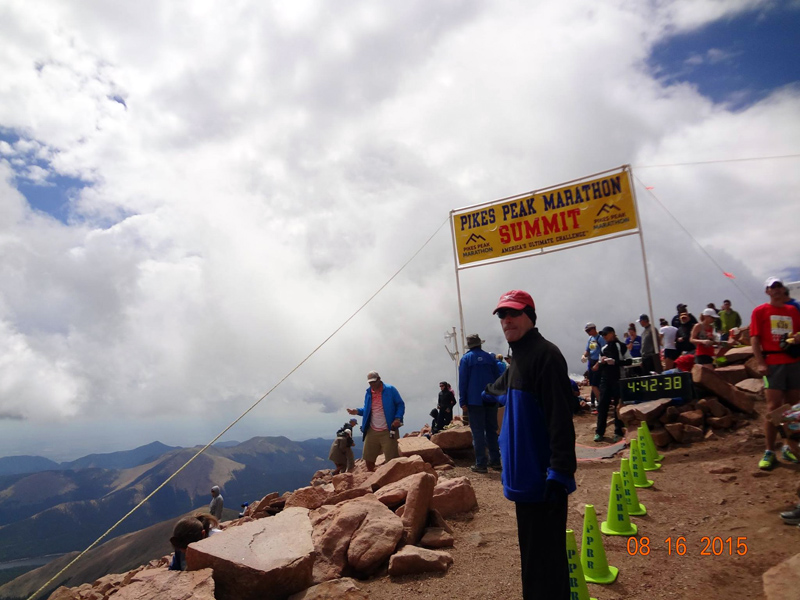
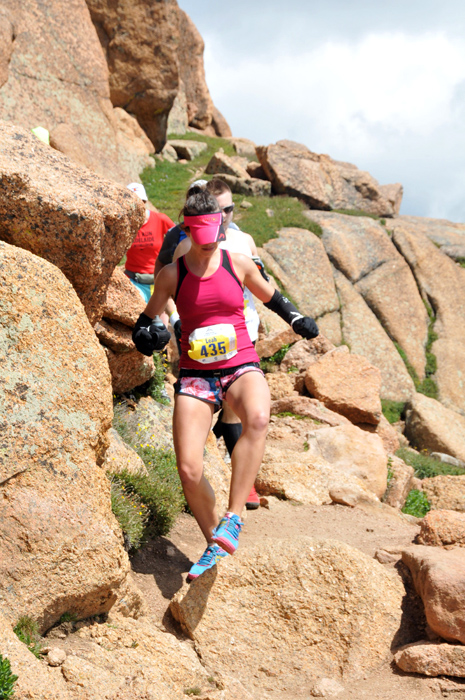
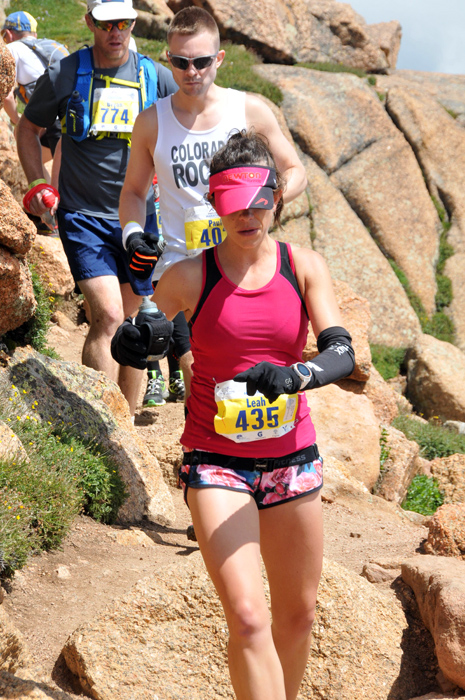
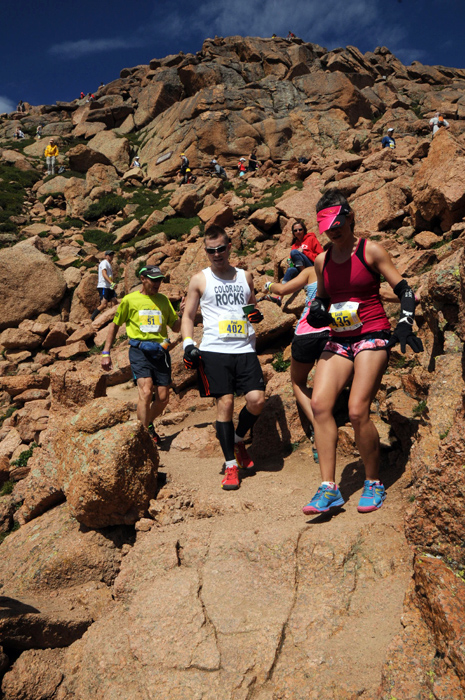
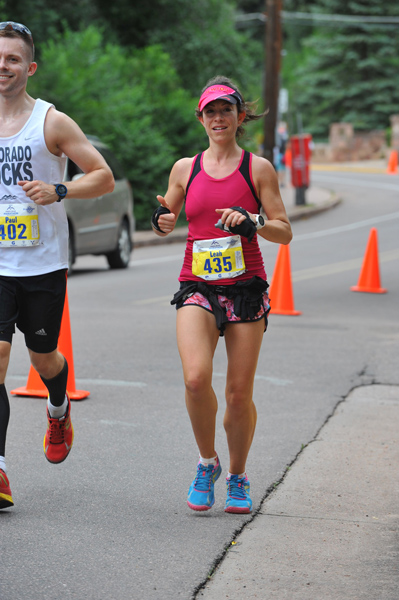
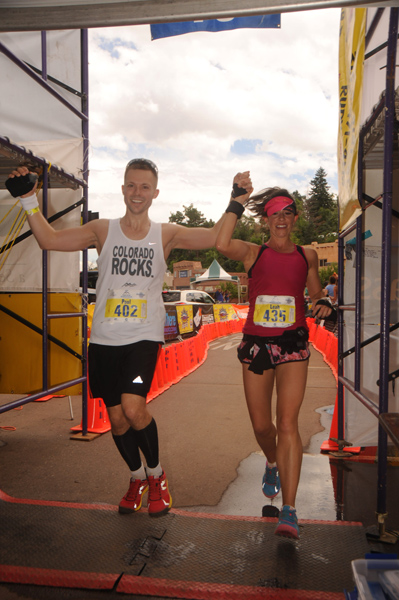

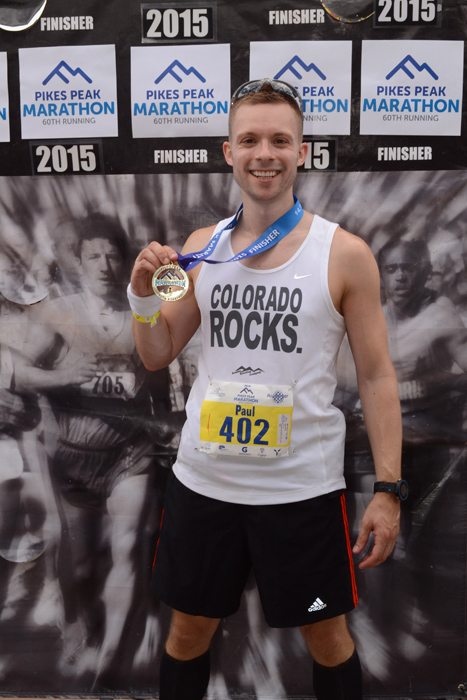
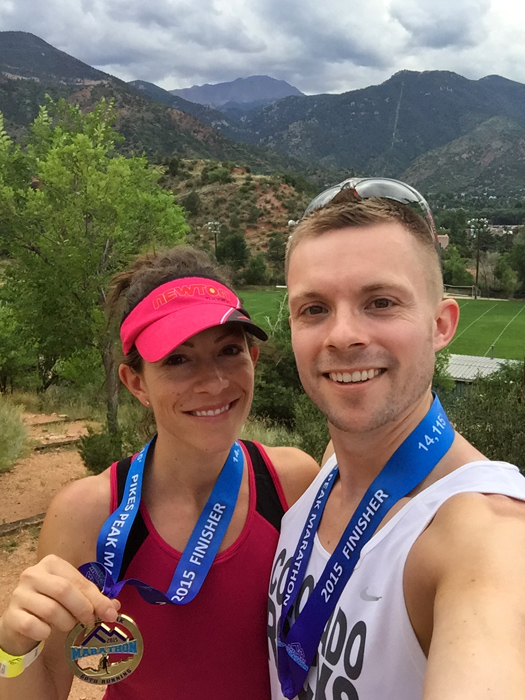

Wow Paul and Leah How ever did u so this race amzing …such will power and a strong mindset to drive yourself over that line …xx
Thanks Linds! Sometimes we still can’t believe it either and it definitely still makes us smile to see the medal hanging there xx
Wow! What an amazing race update! All the way through reading it I kept thinking “did they finish? Did they finish??” I had faith and hoped you did so was happy to see you did finish it! 🙂 such a mammothly hard race! What an achievement! I can imagine how ecstatic you must feel now! Congratulations on finishing the whole thing 🙂 x
Thanks Anne, I think “will we finish, will we finish?” went through our heads a few times too! 🙂 x
Another great read Paul. Truly amazed by the determination and effort you put into your running. I still think that you are nuts, but you both have my full respect and dread to think what your next challenge will be that you take on.
Thanks Jeff! Glad to hear that you think the race writeups make for good reading. Now we’ll just have to keep raising the bar to keep them interesting!!
Couldn’t sleep so went onto Facebook and saw your photo of Pikes Peak. Although I knew the story, to actually read it made it so much more remarkable. You write so well too, really makes it so real. Whenever I am in a difficult situation I always think of what you two go through to achieve your goals. Such determination, strength and courage…..so proud of you! Xx
Thanks Mum, always means so much to hear! Couldn’t do it without your support both now and over the years with all my goals xx
Hey! Found you guys searching for reports on the Maui Oceanfront marathon and then saw you’d run this! I LOVE the PPA/PPM races!
I’m also on a sub-4 Fifty-state endeavor, although churning through them a lot slower, only 1-2 new states a year. :-/
Love the blog – look forward to reading more, and maybe our paths will cross sometime!
Thanks for dropping us a message Andrea. It’s great to hear that you found our site by searching for reports on Maui, it’s exactly what we were hoping for that our reports would show up in people’s searches and be useful to them. Your blog looks fantastic and you post some amazing finishing times! We’ll definitely have a read of your reports and hopefully our paths will cross at an event in CO or maybe even the PPA/PPM 🙂